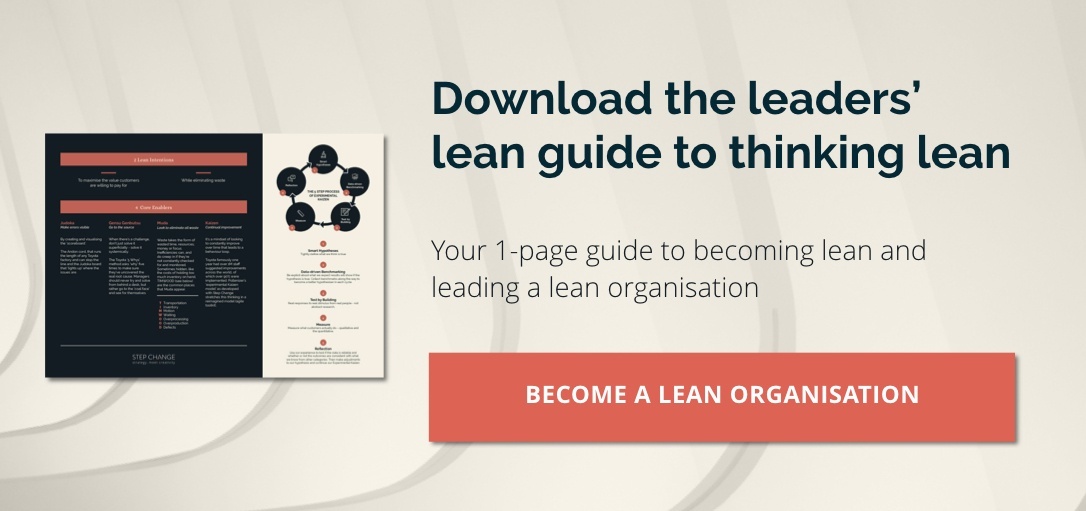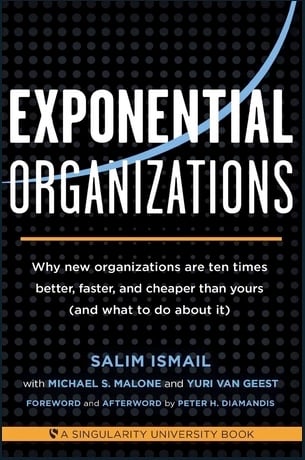Being a Lean organisation means being able to maximise the value customers are willing to pay for while eliminating waste. Leaders are finding more value in it as it’s all about doing more with less, focusing on continuous improvement, minimising waste, and training your staff to improve the work through problem-solving.
So if you aim to create more value for your customers with your limited resources, read on.
Insight: Organisations need to review and simplify complex processes so that decisions are made based on real demand, not just forecasts.
Data: Lean transformations account for an average of “90% reductions in lead time, 50% improvements in productivity, 80% reductions in quality defects and scrap, 75% reductions in space required, and over 80% reductions in inventory investment” (Industry Week)
Key action point: It’s time to challenge the way things are done in your organisations. Download the 1-page guide to Lean to get started.
Lean Organisations: What Makes Them Different?
Lean organisations are geared towards increasing productivity and efficiency and improving quality through effective problem-solving, constant testing, and standardising work.
These organisations are more connected to their customers and knowledgeable of their demands. They are more in tune with the needs of their customers that meeting their expectations comes naturally. All these lead to obtaining a boost in customer retention rates.
Employees are more engaged with their work, resulting in a boost in morale and productivity. This allows Lean organisations to achieve ‘flow’ and see growth in their revenue.
The 4 Core Enablers of Lean Organisations
Judoka: Make Errors Visible
You can do this by creating and visualising the scoreboard.
The Andon cord runs the length of any Toyota factory and can stop the line; the Judoka board is something that lights up where the issues are.
Gensu Genbutsu: Go the Source
When there’s a challenge, don’t just solve it superficially — solve it systemically.
Taiichi Ohno, Toyota’s former EVP, used to advise his staff to dive into and explore problems by asking why five times. This is to make sure they’ve uncovered the real root cause. Managers should never try and solve from behind a desk; rather they should go to the ‘coal face’ and see for themselves.
Muda: Look to Eliminate All Waste
Waste takes the form of lost time, resources, money, or focus. Inefficiencies can, and do, creep in if they’re not constantly checked for and monitored.
Sometimes hidden, like the costs of holding too much inventory on hand.
Here are the common places that Muda appear.
- Defects. This could be in a form of rework, scrap, missing parts, wrong parts, and yield loss at startup
- Inventory. These are materials or extra work that’s not needed to satisfy a customer demand
- Overprocessing. It’s when you’re designing something using more resources than necessary; these resources could be space, energy, or people
- Waiting. When members of your team experience idle time because materials, machines, inspection, or information are not ready for them to use
- Motion. There’s a waste of motion when there’s movement — walking, reaching, searching, lifting, choosing, arranging, and turning — that doesn’t add value to the product
- Transportation. This occurs when there’s movement of materials — through carts or simply through your arms and legs — that adds no value to the product
- Overproduction. The mother of all wastes, overproduction happens when there are more products than the actual demand for it
Kaizen: Continuous Improvement
It’s a mindset of looking to constantly improve over time, which leads to a behaviour loop. Toyota famously had over one million staff-suggested improvements across the world, of which over 90% were implemented.
Pollenizer’s experimental Kaizen model as developed with Step Change stretches this thinking in a reimagined model (The Step Change Agile Toolkit).
5-Step Process of Experimental Kaizen
- Smart hypotheses. Tightly define what we think is true.
- Data-driven benchmarking. Be explicit about what we expect results will show if the hypothesis is true. Collect benchmarks along the way to become a better hypothesiser in each cycle.
- Test by building. Real responses to real stimulus from real people — not abstract research.
- Measure. Measure what customers actually do — qualitative and the quantitative.
- Reflection. Use our experience to test if the data is reliable and whether or not the outcomes are consistent with what we know from other categories. Then make adjustments to our hypothesis and continue our Experimental Kaizen.
Becoming a Lean Organisation
Lean is a management philosophy that cultivates a culture of continuous improvement. The goal? To maximise the value customers are willing to pay for while eliminating waste.
Organisations who have successfully adapted the methodologies of Lean have seen increased productivity, reduced waste, enhanced lead time, and improved customer service.
This is, therefore, your key to growing your business exponentially, allowing you to step up and stay ahead of your competitors.
















